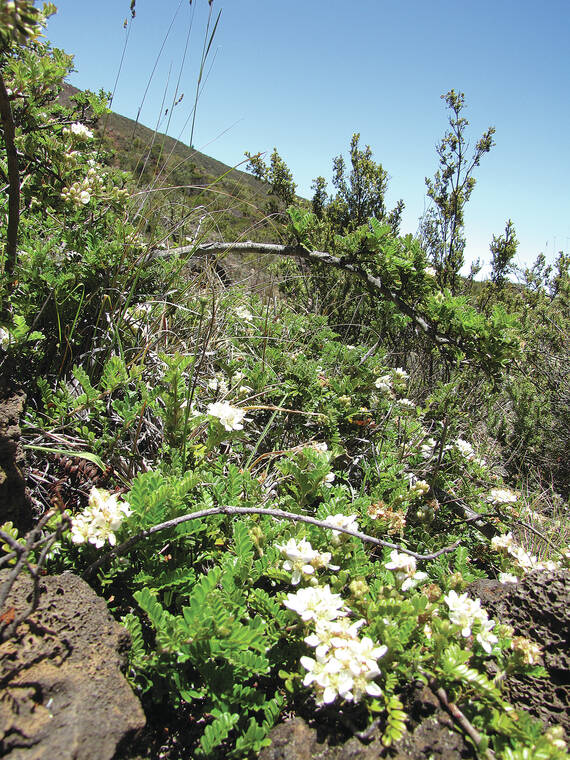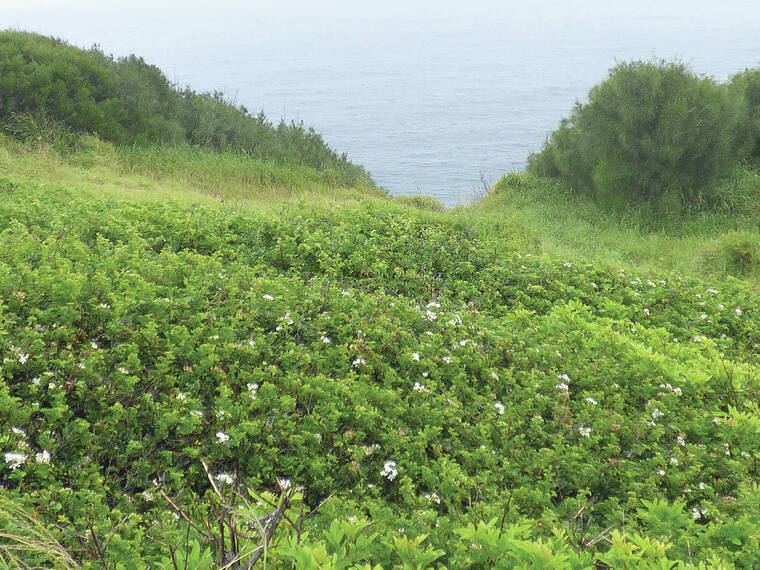t’s always a good idea to consider growing native Hawaiian plants in your garden. Occasionally gardeners report difficulty growing them, however. Those who want to grow more natives and are looking for a very adaptable one, consider ‘ulei. This plant has several different growth habits and some other features that make it an excellent choice for any size garden.
‘Ulei has an arching growth habit with long, flexible branches that can grow along the ground or on a trellis or even as a stand-alone shrub. The branches can reach 15 feet, if left uncut. Each branch holds dark green compound leaves about a foot long with glossy, small, leathery leaflets. The plant also produces clusters of small, white, slightly fragrant flowers. When pollinated, the flowers develop into a small berry-like fruit that ripens to a bluish tint. Sometimes called “Hawaiian blueberry,” the fruit is edible but not very flavorful. When fully mature, the fruit will contain small, very hard seeds.
‘Ulei is a member of the very large rose family, Rosaceae, which includes nearly 3,000 species. Three other members of the same family are also native to Hawaii. The Hawaiian strawberry or ‘ohelo papa (Fragaria chiloensis subsp. sandwicensis) and two species of Hawaiian raspberries or ‘akala (Rubus hawaiensis and R. macraei) are endemic to our islands. ‘Ulei is indigenous to Hawaii and to the Cook Islands and Tonga.
Its adaptable nature means that ‘ulei grows wild in these places as well as here in Hawaii. You might find it along the roadside at upper elevations, just off the trail in Pololu Valley or in the parking lot at Hapuna Beach. In a sunny spot with adequate water and well-drained soil, it can survive from sea level up to 4,000 feet. It can be used as a sprawling prostrate ground cover growing over rocks or as a tree-like plant that can grow over 10 feet.
Elevation, sun exposure and available water affect ‘ulei’s growth habit. Lower elevations and full sun seem to encourage prostrate growth while cooler temperatures, more water and less sun at upper elevations seem to support growth that is more upright. It can be pruned as a shrub or even as a tree. Wet conditions seem to encourage luxuriant growth while dry conditions will initiate flowering.
The genus name for ‘ulei, Osteomeles, comes from the Latin word “osteo” or bone and “meles” or apple probably referring to the fruit that, like an apple, contains hard seeds. Osteomeles anthyllidifolia is usually categorized as a shrub despite its many forms. In all its forms it is attractive and virtually trouble free.
Propagating ‘ulei can be done from cuttings or from seed. Taking cuttings from a mother plant that is growing in the form you prefer will likely produce a similar plant. Cuttings taken in the spring after flowering and fruiting seem to be most successful. Take 4- to 6-inch cuttings that have several buds and are about the diameter of a pencil from the mother plant, dip them in rooting hormones and plant them in a well-drained medium. Using a medium of equal parts perlite and vermiculite works well. Patience is required as rooting can take several months. Once the cuttings start producing new leaves you can consider transplanting to a larger pot and once established there you can install them in the landscape.
The hard seeds can be germinated though it may take one to four months. Seeds can be removed from the mature purplish fruit by soaking it in water then separating the seeds from the softened pulp. Discard any infertile seeds that float. Once the seeds are dried you can store them in a refrigerator for up to a year or prepare them for planting. For the best germination success soak the seeds for a day or two prior to planting. Plant them in a well-drained, porous mix that includes some potting mix as well as about one third perlite.
‘Ulei is a tough plant that can tolerate many soil and climatic conditions. In selecting a spot to plant one out in your garden, a location in full sun is preferable, though it will tolerate partial shade. It can survive in poor soil and in moist as well as dry conditions, but choosing a spot with healthy soil that drains well will help it thrive. It is salt and drought tolerant once established and usually requires little water beyond rain.
‘Ulei is slow growing requiring only very occasional shaping. It can survive very well with little fertilizer. Avoid over fertilizing or over watering to keep the plant insect and disease free.
Few pests bother ‘ulei unless it is stressed. Any attacks by ants, scale, mealy bugs and aphids can be easily controlled if caught early and treated with ant baits and a combination of oil and soap. A mix of neem oil and Dr. Bronner’s soap in a spray bottle with water works well on small infestations.
‘Ulei has many cultural uses. Ancient Hawaiians used the hardwood of large specimens for making o’o bars for digging and spears for fishing. Branches were bent into fishnet hoops as well as fashioned into arrow shafts. The fruit was eaten occasionally but was mostly used to produce a lavender dye. ‘Ulei leaves, flowers and fruit are still woven into lei, today.
‘Ulei is an excellent plant to consider for a low-maintenance garden. It is a hardy xeric plant requiring very little maintenance once established and will add beauty and grace to any site.
Diana Duff is a plant adviser, educator and consultant living part time in Kailua-Kona




